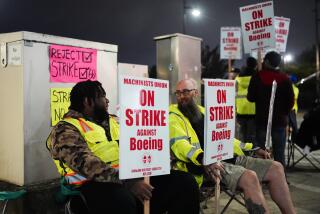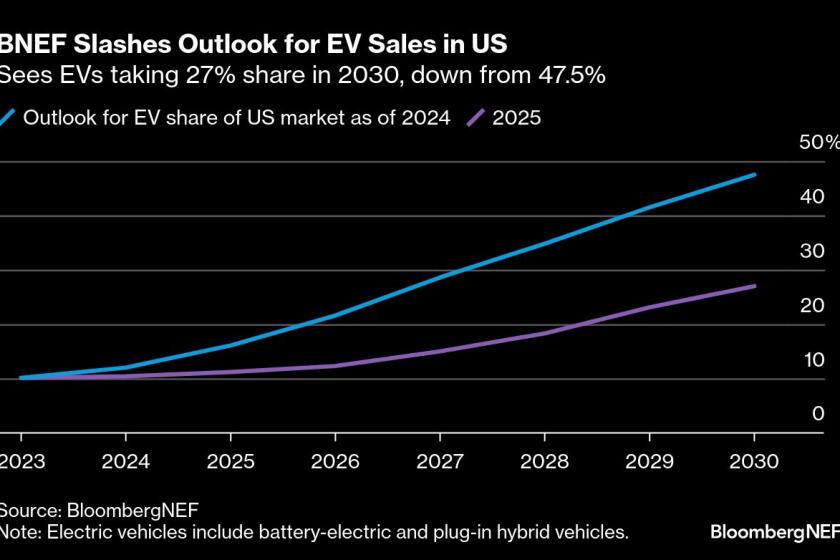New GM Contract Reportedly Offers Workers a 3% Pay Hike : Labor: The United Auto Workers union got a better deal for its retirees but agreed to do away with bonuses for just showing up to work.
- Share via
DETROIT — General Motors will give workers a 3% raise, sweeten the pot for retirees and quit paying bonuses to employees just for showing up, according to industry officials familiar with a tentative agreement GM reached early Monday with the United Auto Workers.
But details of the costliest and most important part of the accord, a program to protect jobs in the face of GM’s need to slash its work force to better compete against foreign-owned auto firms, were sketchy. Terms of the agreement were being kept secret until after UAW leaders meet today with rank-and-file representatives.
For the record:
12:00 a.m. Sept. 19, 1990 For the Record
Los Angeles Times Wednesday September 19, 1990 Home Edition Business Part D Page 2 Column 4 Financial Desk 1 inches; 30 words Type of Material: Correction
UAW--Due to incorrect information from United Press International, the names of United Auto Workers President Owen Bieber and Vice President Stephen P. Yokich were transposed in a photo caption in Tuesday’s paper.
GM and the union reached the agreement early Monday after more than 40 consecutive hours of bargaining. If it is ratified by members across the country, it would replace a three-year agreement that expired at midnight Friday.
The UAW will also try to implement the GM agreement at Ford Motor Co. and Chrysler Corp.
Though empowered to call a strike, union President Owen Bieber ordered the 300,000 workers covered by the expiring agreement to stay off the picket lines while the two sides spent the weekend trying to reach agreement.
Until 1987, the UAW had never opted to work without a Big Three contract rather than hit the bricks. But union officials concede that with so-called transplant auto firms--Japanese companies making cars in this country--poised to grab still more auto sales in case of a strike against an American firm, a walkout could undercut their own long-term interests.
The fact that the Canadian Auto Workers struck Ford at the start of the weekend heightened the stakes further, observers said. With that walkout threatening to cripple as many as seven U.S. plants, Ford would also be vulnerable to losing still more sales to the Japanese-owned, non-union auto plants established in recent years in this country.
Still, the decision to work without an agreement was politically risky for UAW leaders.
“If we didn’t get there (to a settlement) after extending the agreement, we would have looked pretty stupid,” one union official said Monday.
Sources confirmed that the tentative agreement with GM would increase base wages by 3% in the first year, followed by 3% lump sum payments in the second and third years. That duplicates the 1987 auto industry contract.
UAW leaders also succeeded in rebuffing GM’s effort to require employees to make co-payments and be responsible for deductibles on medical insurance, sources confirmed. GM blames the cost of health care for its older work force and pensioners for a $570-per-car cost disadvantage compared to the transplant firms.
Sources also said the tentative agreement increases to $630 the annual bonus paid to retirees in lieu of a cost-of-living allowance. The bonus now ranges up to $400 depending on length of service.
GM managed to do away with one sore spot, an “attendance bonus” in which workers would get $300 for every six months in which they had no unexcused absences from work. But while this eliminated the principle of bribing people to show up for work, it was understood that the $600 payment was salvaged for now in the guise of a “Christmas bonus.”
Policies on absenteeism were also tightened and made to resemble those at some transplant facilities, sources said. That means workers could be fired for repeated failure to come to work, and the union wouldn’t have to defend chronic violators.
By far the biggest item in the agreement, and the one that means most to the workers, is the network of job and income protection programs that were built up at GM in the 1980s while its employment fell by about 170,000.
“It doesn’t do us any good to make $2 more an hour if we’re not going to have a job tomorrow,” said Joe Garcia, secretary-treasurer of Local 645 at GM’s assembly plant in Van Nuys, where 3,800 workers are covered by the UAW agreement.
GM has said it is prepared to spend $3 billion on job security programs but wanted to be free to cut employment by 60,000 in the next three years. The agreement expected to be made public today presumably will try to balance those conflicting goals. By one account, the tentative agreement holds the potential of costing GM $4 billion in a worst-case scenario. This could not be confirmed.
The job-security plan is understood to be patterned after one the union negotiated at J. I. Case, a farm-implement maker, which limits the number of days that workers can be laid off each year, regardless of product sales.
THE TERMS Terms of the settlement between GM and the UAW were not disclosed Monday, but sources said the tentative agreement included these key elements:
A job-security plan that limits the number of days that workers can be laid off each year, regardless of product sales. GM may be prepared to spend $3 billion on job-security programs but may be free to cut employment by 60,000 in the next three years.
An increase in base wages of 3% in the first year, followed by 3% lump sum payments in the second and third years.
An increase to $630 in the annual bonus paid to retirees in lieu of a cost-of-living allowance. The bonus now ranges up to $400.
A $600 Christmas bonus to replace $300 payments to workers for every six months in which they had no unexcused absences from work.
A provision that allows the company to fire workers for repeated failures to come to work, without the union having to defend chronic violators.






